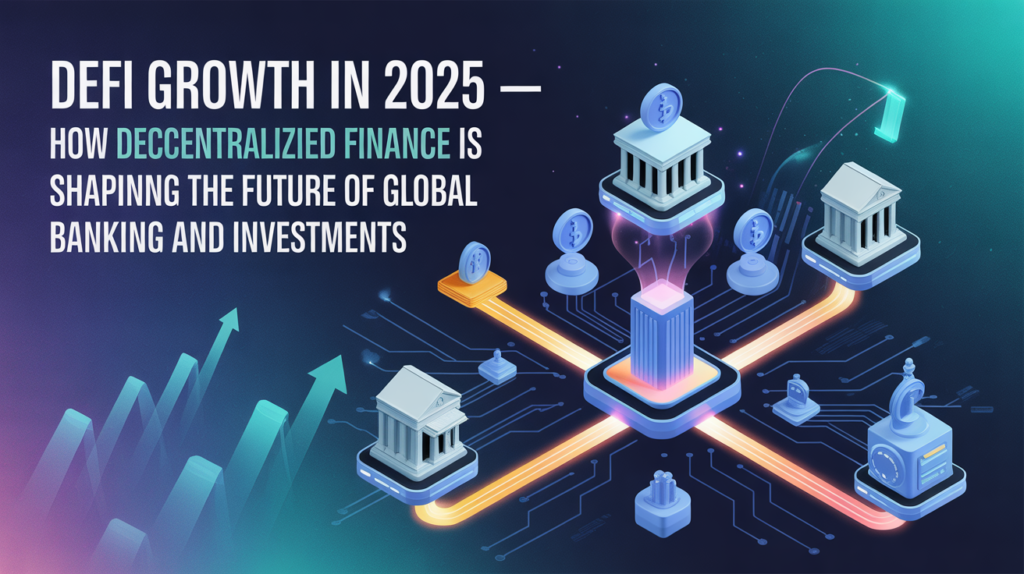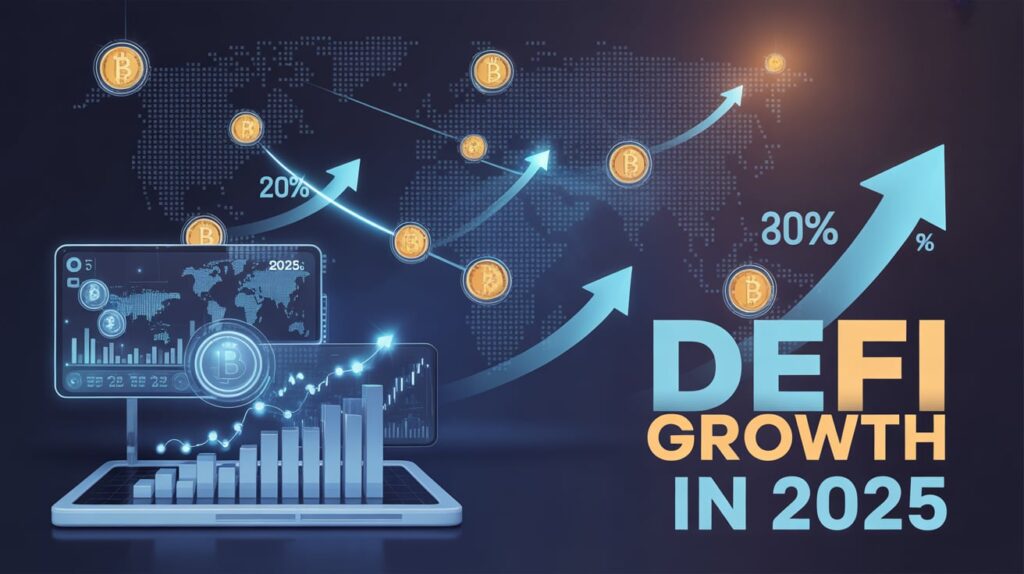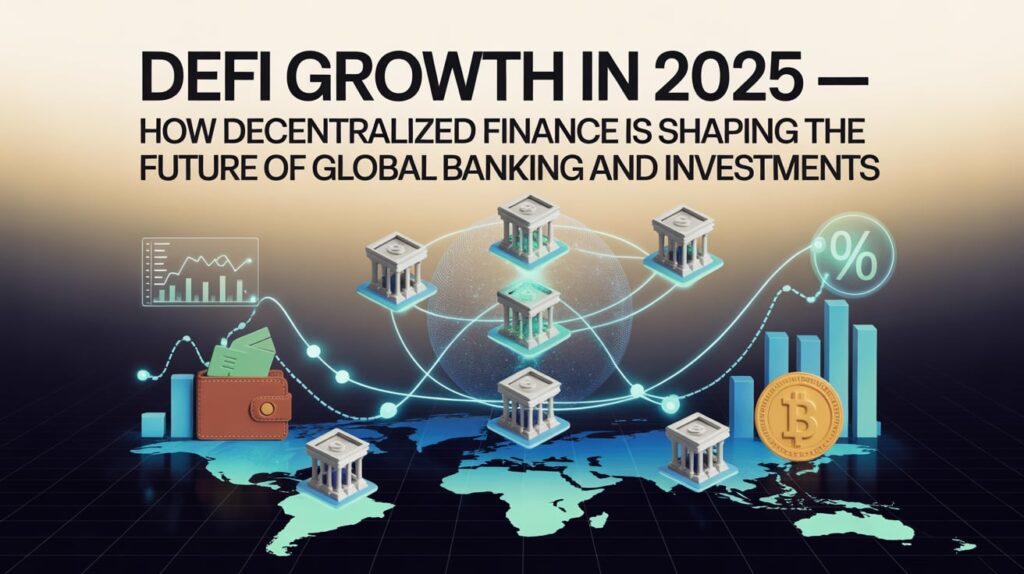DeFi Growth in 2025 — How Decentralized Finance Is Shaping the Future of Global Banking and Investments
The decentralized finance (DeFi) ecosystem has rapidly evolved from an experimental niche into a trillion-dollar financial revolution. In DeFi Growth in 2025, the world is witnessing a new era where traditional banking meets blockchain innovation, redefining how individuals and institutions interact with money.
According to BTCMARKETNEWS, DeFi is no longer a “crypto-only” domain — it’s becoming the backbone of a transparent, inclusive, and borderless global financial system.
The Rise of Decentralized Finance
DeFi — short for decentralized finance — represents a financial system built on blockchain technology that removes intermediaries such as banks and brokers. Instead, it relies on smart contracts to execute financial operations automatically.
In DeFi Growth in 2025, these protocols now offer everything from savings and loans to insurance, derivatives, and asset trading. The result? A financial world that’s faster, fairer, and open to anyone with an internet connection.
BTCMARKETNEWS reports that the total value locked (TVL) in DeFi protocols has surpassed $350 billion globally in 2025, fueled by institutional participation, stablecoin expansion, and cross-chain innovation.
Key Factors Driving DeFi Growth in 2025
1. Institutional Adoption and Regulation
A defining factor in DeFi Growth in 2025 is institutional acceptance. Major financial entities, including BlackRock, JPMorgan, and PayPal, are experimenting with on-chain lending, tokenized bonds, and liquidity pools.
Regulation, once a roadblock, is now an enabler. Governments across the U.S., Europe, and Asia have started adopting DeFi-friendly frameworks that emphasize security, transparency, and consumer protection.
As BTCMARKETNEWS highlights, this clarity has invited banks to integrate DeFi protocols into their services — bridging the gap between decentralized innovation and traditional finance.
2. Stablecoin Expansion and On-Chain Liquidity
Stablecoins are the lifeblood of DeFi. In 2025, USD-pegged tokens like USDC, USDT, and PYUSD dominate the ecosystem, facilitating cross-border payments and collateralized lending.
The emergence of algorithmic and yield-bearing stablecoins has further expanded DeFi’s liquidity base, allowing investors to earn passive income while maintaining price stability.
BTCMARKETNEWS notes that stablecoin transaction volumes in 2025 have exceeded Visa’s global payments network, signaling DeFi’s readiness for mainstream adoption.
3. Layer-2 Scaling and Cross-Chain Interoperability
DeFi’s growth depends on scalability. Layer-2 networks like Arbitrum, Optimism, and zkSync now process thousands of transactions per second with minimal fees.
Meanwhile, cross-chain bridges allow assets to move seamlessly across Ethereum, Binance Smart Chain, Solana, and Avalanche. This interconnectedness has turned DeFi into a multi-chain ecosystem, driving broader user participation.
In DeFi Growth in 2025, interoperability is not just a feature — it’s the foundation for a unified global financial web.
4. Tokenization of Real-World Assets (RWAs)
A standout trend in DeFi Growth in 2025 is the tokenization of real-world assets. Bonds, stocks, real estate, and even carbon credits are being digitized and traded on blockchain platforms.
This innovation democratizes access to high-value investments by enabling fractional ownership, where anyone can invest in global assets with as little as $10.
BTCMARKETNEWS reports that tokenized U.S. Treasury bonds alone account for $8 billion in on-chain value — a sign that DeFi is becoming the new Wall Street.
5. Integration of Artificial Intelligence (AI)
AI and DeFi are merging to create self-optimizing financial systems. In 2025, AI algorithms manage liquidity pools, assess credit risks, and predict market volatility with unprecedented precision.
BTCMARKETNEWS analysts reveal that AI-powered DeFi platforms have increased yield efficiency by up to 35%, attracting both retail and institutional investors seeking smarter portfolio management.
DeFi’s Impact on Global Banking and Investments
A. Financial Inclusion
In developing countries, DeFi provides unbanked populations with access to essential financial services — savings, loans, and insurance — without intermediaries. This is revolutionizing economic inclusion, empowering millions previously excluded from the global economy.
B. 24/7 Banking and Real-Time Settlements
Traditional banking operates within time zones and delays. DeFi, on the other hand, never sleeps. Transactions, lending, and trading occur 24/7, ensuring instant settlements and global liquidity.
As part of DeFi Growth in 2025, banks are now exploring hybrid systems that combine blockchain efficiency with regulatory oversight.
C. New Investment Avenues
Yield farming, staking, and liquidity mining are evolving into sustainable investment models. Investors can now earn interest or governance tokens by providing liquidity or participating in decentralized autonomous organizations (DAOs).
BTCMARKETNEWS notes that DeFi’s transparent structure gives investors complete control over their assets, unlike traditional funds managed by intermediaries.
Challenges Facing DeFi in 2025
While DeFi’s progress is remarkable, it’s not without challenges:
-
Smart Contract Vulnerabilities: Hacks and exploits remain risks if protocols aren’t properly audited.
-
Regulatory Ambiguity in Some Regions: Some countries still lack clear DeFi legal frameworks.
-
User Education: Complex interfaces and technical jargon deter mainstream users.
-
Scam Projects: Fraudulent protocols continue to exploit inexperienced investors.
Despite these challenges, BTCMARKETNEWS emphasizes that the sector’s resilience, coupled with improved security standards and user education, is building a more stable and trustworthy DeFi ecosystem.
Regulatory Developments in 2025
Governments are taking a more constructive approach toward DeFi.
-
The U.S. Digital Asset Framework 2025 sets clear rules for decentralized exchanges (DEXs) and lending protocols.
-
The EU’s MiCA regulation includes DeFi provisions focusing on transparency and auditing.
-
In Singapore and the UAE, sandbox programs allow startups to test DeFi products under regulatory supervision.
These efforts show that regulators are beginning to collaborate with innovators, rather than restrict them — a significant milestone in DeFi Growth in 2025.
The Future of DeFi Beyond 2025
Looking ahead, DeFi will evolve into a unified financial infrastructure, blending decentralized technology with institutional-grade reliability.
By 2030, BTCMARKETNEWS predicts that 40% of global financial transactions will involve some form of blockchain-based settlement. Emerging technologies like zero-knowledge proofs (ZKPs) and quantum-safe cryptography will further enhance privacy, scalability, and security.
In essence, DeFi Growth in 2025 is not the end — it’s the beginning of a new financial era where users, not banks, control their money and investments.
Conclusion
The story of DeFi Growth in 2025 is one of innovation, inclusion, and empowerment. Decentralized finance has moved beyond speculation — it now powers real-world banking, global investments, and digital economies.
As BTCMARKETNEWS continues to track this evolution, one message remains clear: DeFi isn’t just a trend; it’s the architecture of tomorrow’s financial system — borderless, transparent, and unstoppable.
FAQs – DeFi Growth in 2025
1. What is driving DeFi Growth in 2025?
Institutional adoption, regulation, stablecoins, and AI integration are key factors accelerating DeFi expansion globally.
2. How does DeFi differ from traditional finance?
DeFi removes intermediaries, offering peer-to-peer financial services through blockchain-based smart contracts.
3. Is DeFi safe to invest in?
Yes, if you use audited platforms, verified smart contracts, and follow security best practices. Always research before investing.
4. How are regulators approaching DeFi in 2025?
Most governments are adopting pro-innovation frameworks, focusing on compliance, security, and consumer protection.
5. What’s the future of DeFi after 2025?
DeFi will become more interoperable, AI-driven, and institutionally integrated — shaping the foundation of the next global financial era.



